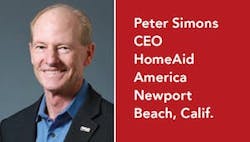Peter Simons on HomeAid's mission to help homeless people stay sheltered
HomeAid America has chapters in 18 markets, offering assistance to the homeless, from emergency shelters and transitional housing to permanent supportive housing. The nonprofit builds and donates these shelters to charities that provide social services for getting residents off the streets, ultimately helping them become self-sufficient. The organization’s roots go back to 1989 when the Orange County chapter of the Building Industry Association (BIA) of Southern California founded HomeAid. In 1995, HomeAid America was created, in an effort to expand outreach throughout the country. To date, builders, trade partners, and other businesses affiliated with the group have built more than 500 shelter projects, with 50 more in development, providing over 9,000 beds per night nationwide.
Q: How did HomeAid America come upon this model of connecting homelessness service providers with the building industry?
A: Back in 1989, the BIA of Orange County was looking for a cause it could collectively get behind to give back to the community and to also create a tangible result that could be seen and appreciated by all. Tackling homelessness made great sense, as builders can have such a huge impact in this area—providing housing is what we do.
The model of getting builders and trades to donate their time and materials to build this housing and give it to nonprofits already working with the homeless also made great sense, and it worked! In the mid-1990s, the decision was made to replicate the model in other parts of the country, and today we have HomeAid chapters in 18 markets from Hawaii to the East Coast, all following the same model and getting great results.
Q: What are the criteria for selecting a service organization that is eligible to receive HomeAid assistance?
A: We look for charities that have a proven track record of helping the homeless in their communities with programs, staffing, and funding to put the housing we build for them to immediate and effective use. We don’t typically build for start-ups, as it’s too risky.
Each chapter of HomeAid can choose to focus on a particular local population experiencing homelessness—such as veterans, youth, single parents, families, domestic-abuse victims, etc.—as long as the ultimate result is helping these people escape the cycle of homelessness.
Q: Let’s say a builder is considering starting a chapter in their market. What can they expect regarding support and resources from HomeAid America?
A: We actually run lead on the creation of all new HomeAid chapters, but if builders or Home Builders Associations [HBAs] in a market that’s currently not served by HomeAid are interested in helping us start a chapter there, we certainly encourage it.
We do have criteria as relates to market size, local homelessness conditions, local building industry dynamics, etc., so we urge builders to contact us through homeaid.org and we’ll work with them to see if it’s a good fit, and will then take the lead if it is.
Q: What’s the biggest barrier to HomeAid expanding to more areas or providing more shelters?
A: Probably the greatest challenge in starting new chapters is getting a local HBA or BIA that’s willing to commit the time it takes to work with us on this. These organizations typically have the local connections we need to reach a critical mass of builders and industry associates to join together in the effort. “It takes a village,” as they say, and having a partner already ensconced in that local community and with a true dedication to the program is critical, but it isn’t always easy to find.
Q: You’ve been involved with HomeAid as CEO since 2013. Has that experience changed your perspective on who are the homeless or how people become homeless?
A: I did indeed take over as CEO in 2013, but as a longtime home builder, I spent over a decade before that working with HomeAid as a volunteer building projects. We’re learning all the time about the causes of homelessness and the best ways to combat them. We are learning all the time about the causes of homelessness and the best ways to combat them. The biggest misconception, and it is far too prevalent, is that those who are homeless are just lazy, irresponsible, or simply “want to live on the street”. This is far from the truth. First of all, 80 percent of those experiencing homelessness in the US are only doing so transitionally due to some life-changing event such as domestic abuse, return from war, financial or medical crisis, or youth losing family support. These are human beings who want, and deserve, the basic human right of a safe and dignified home. Even the 20 percent who have deeper and more chronic issues causing their homelessness don’t want to live on the street, but need more help to stay sheltered, and I believe we owe them that as a society. As builders, we can have an especially big impact in this area as housing is ultimately what is needed to end homelessness, and that is what we do.

